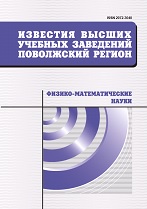|
This article is cited in 4 scientific papers (total in 4 papers)
Mathematics
Approximate methods for calculating hypersingular integrals
I. V. Boykov, P. V. Aykashev
Penza State University, Penza, Russia
Abstract:
Background. Hypersingular integrals are now finding more and more fields of application - aerodynamics, elasticity theory, electrodynamics and geophysics. Moreover, their calculation in an analytical form is possible only in very special cases. Therefore, approximate methods for calculating hypersingular integrals are an urgent problem in computational mathematics. Many works have been devoted to this problem. An even greater number of works are devoted to approximate methods for calculating singular integrals. Studies of approximate methods for calculating singular integrals began much earlier than similar studies of hypersingular integrals. In this direction, results have been obtained that have no analogues for hypersingular integrals. This work is devoted to considerable interest to extend the methods for calculating singular integrals to hypersingular integrals, based on the connection between some classes of singular and hypersingular integrals. Materials and methods. The construction of quadrature formulas for calculating hypersingular integrals is based on the methods of the constructive theory of functions and the theory of singular and hypersingular integrals. Results. A method is proposed for constructing quadrature formulas for calculating hypersingular integrals, based on the transformation of quadrature formulas for calculating singular integrals. Quadrature formulas for calculating several classes of hypersingular and polyhypersingular integrals are constructed. The estimates of the error of the constructed quadrature formulas are obtained. Conclusions. The constructed methods make it possible to efficiently calculate hypersingular integrals when solving applied problems.
Keywords:
quadrature formulas, cubature formulas, hypersingular integrals.
Citation:
I. V. Boykov, P. V. Aykashev, “Approximate methods for calculating hypersingular integrals”, University proceedings. Volga region. Physical and mathematical sciences, 2021, no. 1, 66–84
Linking options:
https://www.mathnet.ru/eng/ivpnz21 https://www.mathnet.ru/eng/ivpnz/y2021/i1/p66
|

| Statistics & downloads: |
| Abstract page: | 131 | | Full-text PDF : | 54 | | References: | 29 |
|




 Contact us:
Contact us: Terms of Use
Terms of Use
 Registration to the website
Registration to the website Logotypes
Logotypes








 Citation in format
Citation in format 
